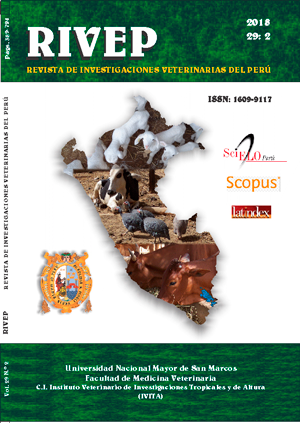Seroprevalence of the porcine reproductive and respiratory syndrome virus in non-technically managed pig herds of Peru
DOI:
https://doi.org/10.15381/rivep.v29i2.14497Keywords:
pig, PRRSV, antibodies, prevalence, poor managed pig herdsAbstract
The objective of this study was to determine the seroprevalence of the Porcine Reproductive and Respiratory Syndrome Virus (VPRRS) in non-technologically managed pig herds of 23 departments of Peru. Blood samples (n=4526) were collected from male and female pigs older than four weeks of age between October 2015 and March 2016 for the detection of antibodies against the VPRRS by the indirect ELISA test. The 17.3% (95% CI: 16.3-18.5) of the pigs had antibodies against the VPRRS. The average seroprevalence of the virus was 25.7% (95% CI: 23.6-27.9) in pigs of the central region, followed by those of the northern region with 14.8% (95% CI: 12.9-16.7) and southern area of the country with 11.5% (95% CI: 10.0-13.1). The seroprevalence of the VPRRS in pigs of the department of Lima was 62.2% (95% CI: 57.7-66.6), followed by pigs from the department of Arequipa with 37.9% (95% CI: 31.1-44.6) and Lambayeque with 31.3% (95% CI: 22.0-40.5). There was statistical association (p<0.05) between the sex of the pigs and the presence of antibodies against the VPRRS within the group of animals from 27 to 52 weeks. The presence of antibodies against the VPRRS detected in non-technologically managed farms across the country indicates that the animals were exposed to the field virus, since the prevention of the disease through vaccination is not allowed in the country.Downloads
Downloads
Published
Issue
Section
License
Copyright (c) 2018 Miguel Quevedo V., Jorge Mantilla S., Katherine Portilla J., Rubén Villacaqui A., Hermelinda Rivera G,

This work is licensed under a Creative Commons Attribution-NonCommercial-ShareAlike 4.0 International License.
AUTHORS RETAIN THEIR RIGHTS:
a. Authors retain their trade mark rights and patent, and also on any process or procedure described in the article.
b. Authors retain their right to share, copy, distribute, perform and publicly communicate their article (eg, to place their article in an institutional repository or publish it in a book), with an acknowledgment of its initial publication in the Revista de Investigaciones Veterinarias del Perú (RIVEP).
c. Authors retain theirs right to make a subsequent publication of their work, to use the article or any part thereof (eg a compilation of his papers, lecture notes, thesis, or a book), always indicating the source of publication (the originator of the work, journal, volume, number and date).



